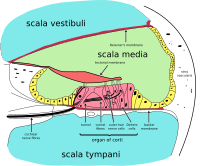
Photo from wikipedia
ABSTRACT Auditory efferent neurons reside in the brain and innervate the sensory hair cells of the cochlea to modulate incoming acoustic signals. Two groups of efferents have been described in… Click to show full abstract
ABSTRACT Auditory efferent neurons reside in the brain and innervate the sensory hair cells of the cochlea to modulate incoming acoustic signals. Two groups of efferents have been described in mouse and this report will focus on the medial olivocochlear (MOC) system. Electrophysiological data suggest the MOC efferents function in selective listening by differentially attenuating auditory nerve fiber activity in quiet and noisy conditions. Because speech understanding in noise is impaired in age‐related hearing loss, we asked whether pathologic changes in input to MOC neurons from higher centers could be involved. The present study investigated the anatomical nature of descending projections from the inferior colliculus (IC) to MOCs in 3‐month old mice with normal hearing, and in 6‐month old mice with normal hearing (CBA/CaH), early onset progressive hearing loss (DBA/2), and congenital deafness (homozygous Shaker‐2). Anterograde tracers were injected into the IC and retrograde tracers into the cochlea. Electron microscopic analysis of double‐labelled tissue confirmed direct synaptic contact from the IC onto MOCs in all cohorts. These labelled terminals are indicative of excitatory neurotransmission because they contain round synaptic vesicles, exhibit asymmetric membrane specializations, and are co‐labelled with antibodies against VGlut2, a glutamate transporter. 3D reconstructions of the terminal fields indicate that in normal hearing mice, descending projections from the IC are arranged tonotopically with low frequencies projecting laterally and progressively higher frequencies projecting more medially. Along the mediolateral axis, the projections of DBA/2 mice with acquired high frequency hearing loss were shifted medially towards expected higher frequency projecting regions. Shaker‐2 mice with congenital deafness had a much broader spatial projection, revealing abnormalities in the topography of connections. These data suggest that loss in precision of IC directed MOC activation could contribute to impaired signal detection in noise. HighlightsThe IC sends tonotopic, glutamatergic projections to medial olivocochlear efferents.IC synapses to medial olivocochlear efferents are retained in hearing loss and deafness.IC projections to MOC efferents exhibit loss of precision with hearing loss and deafness.
Journal Title: Hearing Research
Year Published: 2017
Link to full text (if available)
Share on Social Media: Sign Up to like & get
recommendations!